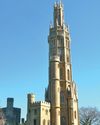
Three guesses as to the role of this oddly beautiful little building in the churchyard of St Mary’s at Hartpury, Gloucestershire.
A handsome prize awaits those who can give the right – and very surprising – answer: that it is a 19th-century structure for sheltering bees!
Fancied up to the nines with elaborate carving, it is eight yards long and two yards high, with two tiers of convex and concave scalloped stone, zigzags adding cutting-edge brio to its joyful appearance.
These were the partitions that protected the ‘skeps’ – in this case, 28 of them, housing some 840,000 bees. Skeps were the straw domes, of satisfyingly complex, plaited construction, that sheltered the colonies of creatures making their honey.
Doric pilasters march along the lowest tier, flanking five Gothic arches – two with molded keystones – with sunken circles in their spandrels. A continuous line of stone diamonds against a rusticated background completes this happy, unique-in-the-world decorative picture.
The stone caps are of the pleasingly named oolite Cleeve Pea Grit and the ‘plates’ are of Purbeck stone. Such construction methods, with bees and their boles, although minus these picturesque extras, had been popular throughout the world up until the mid-19th century.
This story is from the May 2020 edition of The Oldie Magazine.
Start your 7-day Magzter GOLD free trial to access thousands of curated premium stories, and 8,500+ magazines and newspapers.
Already a subscriber ? Sign In
This story is from the May 2020 edition of The Oldie Magazine.
Start your 7-day Magzter GOLD free trial to access thousands of curated premium stories, and 8,500+ magazines and newspapers.
Already a subscriber? Sign In

Travel: Retreat From The World
For his new book, Nat Segnit visited Britain’s quietest monasteries and islands to talk to monks, hermits and recluses

What is... a nail house?
Don’t confuse a nail house with a nail parlour. A nail house is an old house that survives as new building development goes on all around it.

Kent's stairway to heaven
Walter Barton May’s Hadlow Castle is the ultimate Gothic folly

Pursuits
Pursuits

The book that changed the world
On Marcel Proust’s 150th anniversary, A N Wilson praises his masterpiece, an exquisite comedy with no parallel

RIP the playboys of the western world
Charlie Methven mourns his dashing former father-in-law, Luis ‘the Bounder’ Basualdo, last of a dying breed

Arts
Arts

My film family's greatest hits
Downton Abbey producer Gareth Neame follows in the footsteps of his father, grandfather and great-grandmother, a silent-movie star

Books
Books

A lifetime of pin-ups
Barry Humphries still has nightmares about going on stage. He’s always admired the stars who kept battling on